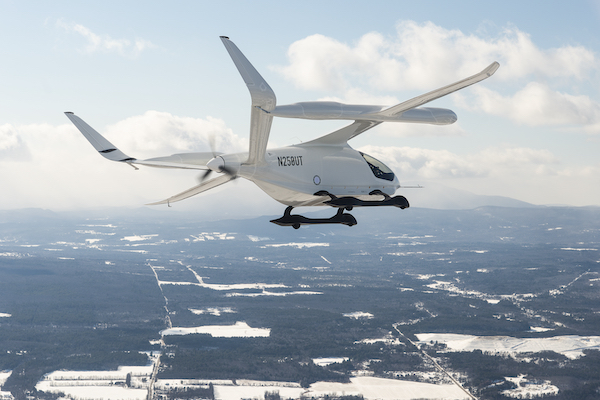The runway for futuristic electric planes is still a long one
The future of flight will come in stages, for one electric aircraft startup at least.
Today, Beta Technologies, pushed back the debut of its futuristic electric aircraft that can take off and land like a helicopter. Instead, it announced plans to certify a more conventional version of its electric plane by 2025.
Beta is one of a growing number of companies working to build small electric aircraft that can carry several passengers or small cargo loads for short distances. Many of these aircraft are a class of vehicles called eVTOLs (electric vertical take-off and landing), designed to take off and land without conventional runways.
We're trying to create a sustainable aviation future, and that's a big, lofty goal," says Kyle Clark, Beta's founder and CEO. The company has largely focused on cargo delivery, raising over $800 million in funding and securing orders for its eVTOL aircraft from companies like UPS, Blade, and Air New Zealand.
Aviation makes up about 3% of global greenhouse-gas emissions today, and the industry's contribution to climate change is growing. Electric aircraft could help cut emissions, but technical and regulatory hurdles still loom for the industry, which is one reason Beta is starting with aircraft that behave less like air taxis and more like ... well, planes.
Beta isn't scrapping its plans for an eVTOL, but it plans to first certify a more conventional plane called the CX300, which will need to take off and land on a runway. The company has flown this type of aircraft in test flights totaling over 22,000 miles, both close to its base in Vermont and in treks across the country: it's traveled to Arkansas (a trip of about 1,400 miles, or 2,200 kilometers) and Kentucky (800 miles, or 1,200 kilometers) on separate occasions. Those longer trips require stops along the way to top off the battery, but Beta's aircraft has flown as far as 386 miles on a single charge.
 Beta's electric plane during a flight test in Plattsburgh, New York.BETA
Beta's electric plane during a flight test in Plattsburgh, New York.BETABeta's approach is to go after electric flight in an intensely pragmatic way, and in a way that doesn't require three or four miracles to happen at once," Clark says, referring to both the technical challenges that face next-generation electric aircraft and the regulatory barriers ahead for the industry.
Several of the largest eVTOL startups have announced plans to enter commercial service in 2025. Those plans hinge on getting approval from the Federal Aviation Administration, the regulatory body for civil aviation in the US. Safety will dictate the certification timeline, but we could see these aircraft in the skies by 2024 or 2025," the FAA said in an emailed statement.
New eVTOL aircraft will be subject to a different FAA certification framework from conventional aircraft. Because of that special process, some in the industry doubt that either the agency or the companies will be able to meet the announced timelines.
Beta plans to certify its eVTOL aircraft for service in 2026. Others say the agency might take until later in the decade to issue approvals. It's going to take longer in terms of certification, probably 2027 or 2028," says Matthew Clarke, a postdoctoral fellow in aeronautics and astronautics at MIT. These conventional electric aircraft will take off first."
Switching out fossil fuels for batteries will already represent a major change for aviation, since electric aircraft will have new propulsion systems and carry batteries on board.
Using batteries to get around is a common tactic for building more climate-friendly transit. Electric cars reached about 13% of new car sales in 2022. Buses, trains, and ships could all be powered by batteries, at least in some scenarios.
But aviation will have a more difficult time following the same path, largely because batteries are heavy. Every ounce matters for vehicles that need to cruise thousands of feet in the air, and bigger planes traveling longer distances would need bigger, heavier batteries, which is why most efforts in electric aviation so far have focused on smaller aircraft.
Beta's conventional electric planes will also be small, and the company's focus is on short-haul passenger travel and cargo delivery. Other companies, including Harbour Air and Eviation, are taking a similar approach, focusing on building conventional electric alternatives to small planes.
Smaller planes represent a small portion of traffic today, though: for passenger travel, commuter aircraft (around 19 or fewer seats) make up about 4% of all departures and about 0.03% of revenue-passenger-kilometers, a measure of the total money, passengers, and distance flown. So batteries would have a bigger influence in aviation if smaller aircraft began playing a larger role-hence the undying dream of eVTOLs.
Beyond possible climate benefits over planes powered by fossil fuels, eVTOLs could expand options for flight, Clarke says. Because they don't need a runway, the vehicles could be used for last-mile delivery of freight, travel in dense urban spaces, or military applications. This flexibility is part of the appeal, driving billions of dollars in total funding into eVTOL startups like Joby, Archer, and Lilium.
There are plenty of questions ahead for eVTOLs, from where they'll land and how much noise they'll make to how they'll compare with ground-based transportation options in climate impact.
Conventional-looking electric aircraft might be a placeholder while the industry figures out the answers to those questions. But however they fly, planes that are powered without fossil fuels will be a piece of the climate puzzle. If we don't do anything about it, aviation will be the top producer of carbon emissions in transportation by 2035," Clark says. And we're not going to let that happen-not on our watch."